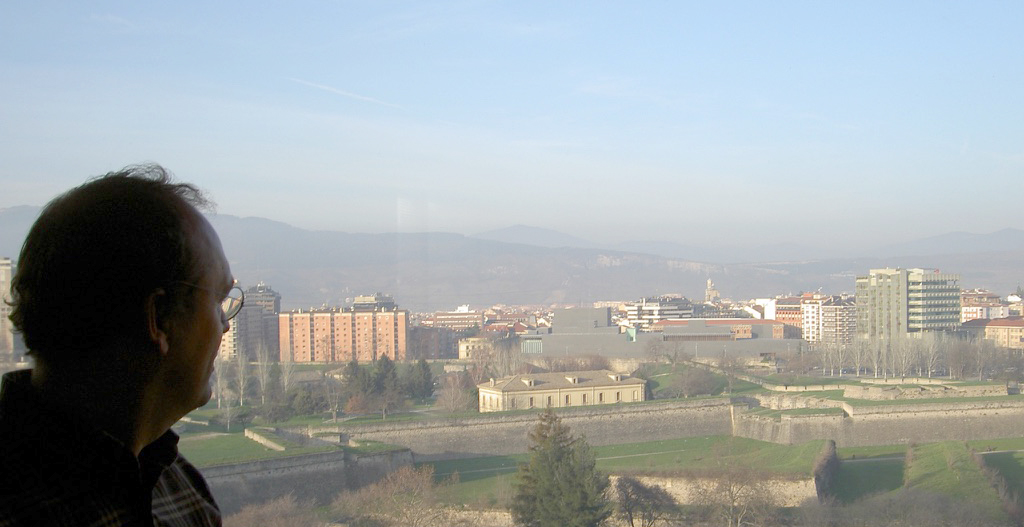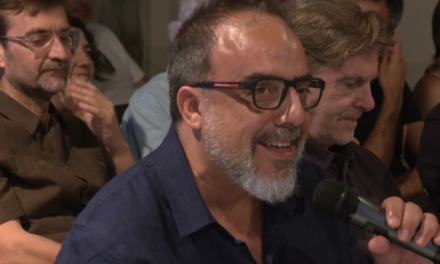[English]
What have been the influences, challenges and consequences of staying in Pamplona for you?
Héctor Gato Cid, UPM ETSA Madrid, End of Course Project student.
Patxi Mangado: I have always been the kind of person who has intuitions and they work for me. Obviously, these intuitions must be based on knowledge. And I had a clear intuition that my place was here, in Pamplona. I can’t deny there was probably an element of fear in that decision. At a time when post-modernity reigned, when the leading schools of architecture like Madrid and Barcelona were immersed in organisational chaos, I decided to stay in Pamplona, where at the time, architecturally speaking, there was still a lot to be done. I believed I would have more of an opportunity to develop what I had been taught by Echaide: a more scientific, more objective style of architecture.
I’m not a ‘natural born’ architect. For me it is more a question of willpower. Genius, despite my intuitions, does not form part of the equation. I decided not to work in a major studio, where I might have had earlier opportunities to prove myself as an architect. But I think time has proved me right and despite the fact that communications and the transmission of information were not as fluid then as they are now, we have ended up with a system where it does not matter where you work but how you work. I believe that you have more of a chance to show your worth outside the mainstream.
The School of Architecture was, and still is, very important to me. We would say, “This has to change; it’s becoming essential to compete with the outside world. We cannot continue to work in a vacuum; we must find contact and communication mechanisms that will enrich us. Everybody knows it’s possible to generate an area of common understanding, independent of your physical space – well, let’s get on the bandwagon!” And visiting professors started to come to Pamplona; we started to do exchange programmes etc. I remember, that, during those years of change, I was working in Pamplona and teaching at Harvard GSD at the same time. It was a critical experience for me: I learnt a great deal – especially about action mechanisms, some of which would be later applied at the school of Pamplona.
So, the School became both a fascinating job and was a great source of enrichment for me. The upshot is that the region of Navarre has become an academic point of reference of the first order, and I think I have had something to do with that. I don’t believe that this is a presumption. I believe I can say this objectively and that, at the end of the day, this all goes to prove that I was not wrong to stay here.
But there are always two sides to a story: this entire struggle has been at an extraordinary personal cost to me. I have the feeling, why hide it? that at my 46 years of age I have used myself up to an extent that others don’t reach until they are 60 years old.
The story behind my buildings is the story of an immense effort.
[Español]
¿Qué influencias, retos y consecuencias tiene para ti haberte mantenido en Pamplona?
Héctor Gato Cid, estudiante de Proyecto Fin de Carrera de la ETSA de Madrid, UPM
Siempre he sido una de esas personas que tienen intuiciones, y éstas funcionan. Claro que esas intuiciones han de estar ilustradas desde el conocimiento. Intuí claramente que mi posición estaba aquí en Pamplona. Probablemente, en ese juicio había algo de miedo, no lo descarto. En un momento en el que triunfaba la posmodernidad, en el que las escuelas de referencia como Madrid o Barcelona estaban inmersas en un caos organizativo, y en un entorno, Pamplona, donde desde el punto de vista de la arquitectura todo estaba por hacer, decidí mantenerme. Pensé que tendría más oportunidades para desarrollar aquellas enseñanzas de Echaide, una arquitectura más objetiva, más científica. Nunca he sido un arquitecto de sangre, sino más bien de voluntad. La genialidad, a pesar de mi intuición, no entra en mis esquemas. Renunciaba a trabajar en estudios importantes, pero también es cierto que aquí podría tener antes trabajos para demostrar mi capacidad como arquitecto. El tiempo creo que me ha dado la razón, y aunque entonces la cuestión de las comunicaciones y la transmisión de información no era tan fluida como ahora, hemos acabado en un sistema en el cual no importa dónde trabajas sino lo que trabajas. En la periferia, seguramente, esta capacidad para demostrar lo que vales es mayor.
La Escuela de Arquitectura de Pamplona era y es para mí muy importante. Nos dijimos: ‘Esto hay que cambiarlo. Se hace necesario competir con el exterior. No podemos continuar con un modelo cerrado y hemos de buscar mecanismos de contacto y comunicación que nos enriquezcan. Todo el mundo es consciente de que se puede, independientemente del espacio físico, generar un espacio común. ¡Pues participemos del mismo!’ Y empezaron a venir profesores visitantes, a cambiar los programas, etc. Recuerdo que en aquellos años de cambio yo simultaneaba mi presencia en Pamplona con la docencia en la GSD de Harvard. Fue una experiencia fundamental: aprendí mucho, especialmente mecanismos de acción, algunos de los cuales se aplicarían luego en la Escuela de Pamplona.
Así, la Escuela se convirtió en un trabajo ilusionado y también en un gran proceso enriquecedor. El resultado es que hoy Navarra se ha convertido en un referente académico de primer orden y yo creo que algo tengo que ver con ello. No es presunción, creo que lo que digo es objetivo, y en el fondo todo ello demuestra, de alguna manera, que no me equivoqué.
La otra cara de la moneda también existe: toda esta lucha ha supuesto, fundamentalmente en términos personales, un coste extraordinario y también, por qué no decirlo, la sensación de que he agotado un ciclo a mis 46 años que otros lo agotan a los 60.
La historia de mi arquitectura es la historia de un esfuerzo.
Los nueve extractos que corresponden a la conversación, con Félix Arranz, son:
The nine extracts from the conversation with Félix Arranz are:
01 architecture is something that can be learnt | la arquitectura es algo que se puede aprender
02 un arquitecto de oficio | the trade of the architect…
03 intentar hacer cosas que no sé hacer | on trying to do things I don’t know how to do…
04 el paso intermedio | the intermediary stages…
05 saber el límite | knowing the limits…
06 obsesión por los materiales, por la materialidad | an obsession for materials, for the material nature of things…
07 como una espoleta | like a fuse…
08 le pido a un estudiante | what I ask of a student…
09 pregunta de un estudiante | a question from a student…
INDEX …self Patxi Mangado, 9 chapters extractos










